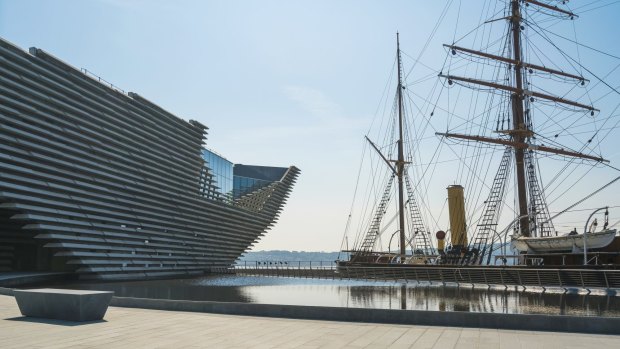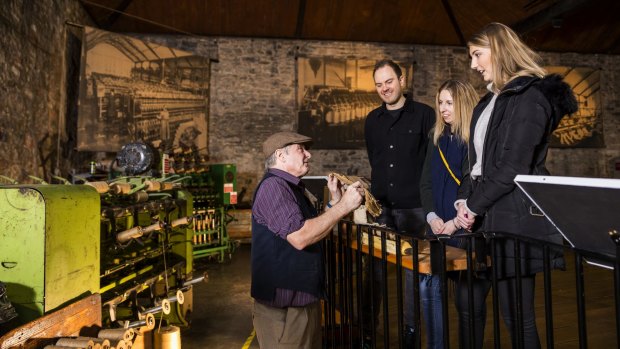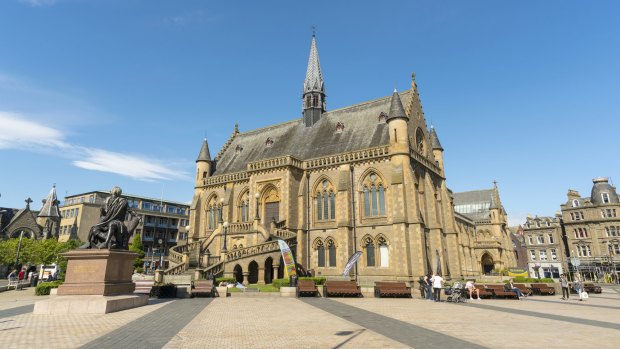This was published 1 year ago
Dundee is a scottish city worth a detour for its rich design heritage

Pictured: Scotland's premier design museum alongside the most famous ship ever built on Tayside: Robert Falcon Scott's Discovery.Credit: VisitScotland / Kenny Lam
It's a sunny spring afternoon in Scotland's fourth largest city and the High School of Dundee's school pipes and drums band is practising in the open air wafting over Albert Square, under the watchful gaze of Robert (Rabbie) Burns — Scotland's Shakespeare. Or at least his statue.
The bagpipe tunes have hardly changed since Rabbie's day. Mournful, stirring, becoming of kilted men about to march into a probably losing battle.
Dundee is a city easy to pass by if you're heading from Glasgow or Edinburgh to the Highlands, the Hebrides or even John O'Groats, the most northerly place on the British mainland. Unlike, say, Perth or Pitlochry it requires a diversion. So is it worth it?

Verdant Works is arguably the UK's only museum devoted to the jute industry.Credit: VisitScotland / Kenny Lam
Photographs in Verdant Works, arguably the UK's only museum devoted to the jute industry, prove Dundee deserved its title as "the city of church spires and chimney stacks".
One or two of those tall chimneys came with the sticky, sweet smell of jam or marmalade. Most, however, came with a noxious stench from the jute factories.
No matter how tall the chimneys — and they were some of the tallest in Britain — the people of Dundee's health suffered as a result of the city's prosperity.

The McManus Art Gallery and Museum is one of Scotland's finest.Credit: VisitScotland / Kenny Lam
Today barely a chimney stack survives. Dundee, a former UNESCO City of Design, has reinvented itself. It's now a self-declared "Boom City" with one of the biggest and best teaching hospitals in the UK.
It is fun, I hear you ask?
My childhood (and that of many of fellow British contemporaries) was enlivened each week by the comic book antics of the Bash Street Kids, Lord Snooty, Beryl the Peril and Roger the Dodger.
Think Ginger Meggs many times multiplied.
The Beano and the Dandy came through our letterbox as regularly as homework, all produced in Dundee by the company founded by one of Britain's oddest media entrepreneurs (and there have been a few): David Couper Thomson.
Thomson was as eccentric as any of his cartoon creations. Even in the 20th century he refused to employ Catholics or union members. That ultra-conservative bias might have been more evident in his newspapers (the Dundee Courier and Daily Argus), but was never apparent in his comics.
Rabbie Burns' statue has its back turned to what has now been rebadged as The McManus Art Gallery and Museum (one of Scotland's finest and designed by Sir Gilbert Scott of the Houses of Parliament fame). However it also gazes over the historic DC Thomson building, mimicking a New York skyscraper from the Flatiron period.
Burns is hardly alone when it comes to statues. Oor Willie (a Scottish delicacy much like haggis), Desperate Dan and Minnie the Minx are all represented at various points of the city.
But let's return to the heart of Dundee, the Tay.
Flowing from the Highlands, the Tay is the longest river in Scotland (and the seventh longest in the UK). Perth owes its prominence from its bridge over the Tay, but by the time the river arrives downstream at Dundee, it has become a firth (the Scots name for estuary, though locals will tell you a firth has more undiluted salt water than an estuary).
My hotel, the Belle Epoque Malmaison Dundee (opening in 1899 as Mathers Hotel), is superbly placed to explore the riverfront and docklands. Shipbuilding used to be one of Dundee's main industries (along with the "three Js": jute, jam and journalism). However the last Dundee shipyard closed in 1983.
Fortunately the dockyard — just a harpoon away from Dundee's Viking longboat-shaped Victoria and Albert Museum, Scotland's premier design museum — harbours the most famous ship ever built on Tayside: Robert Falcon Scott's Discovery. As we all know, Scott was beaten to the South Pole by the Norwegian team led by Roald Amundsen. Scott's exploits have been variously recorded, from heroic chancer to poor logistical leader.
Yet Discovery, built in 1901 based on the wooden-hulled whaling ships (fashioned from oak, pitched pine and an iron-like tree from Africa) Dundee had produced for generations, is back where it belongs. Our guide asks us to note its "pointed bow", all the better to smash through Antarctic ice.
There were 47 men aboard Discovery when it arrived on earth's most isolated continent. Whatever Scott's failure's, Discovery claims to be the first ship specifically built for scientific research.
A typical meal before Scott's sledge party left for the Pole was "roast penguin and seal's liver": fortunately not on the menu at the Malmaisson.
THE DETAILS
STAY
Malmaison Dundee, across the road from the railway station, sooms from $110. See malmaison.com/locations/dundee
VISIT
Victoria and Albert Museum Dundee: vam.ac.uk/dundee
The McManus: mcmanus.co.uk
Steve Meacham visited at this own expense.
Sign up for the Traveller Deals newsletter
Get exclusive travel deals delivered straight to your inbox. Sign up now.